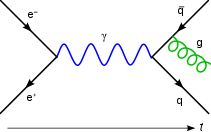In physics, specifically field theory and particle physics, the Proca action describes a massive spin-1 field of mass m in Minkowski spacetime. The corresponding equation is a relativistic wave equation called the Proca equation. The Proca action and equation are named after Romanian physicist Alexandru Proca.
The Proca equation is involved in the Standard Model and describes there the three massive vector bosons, i.e. the Z and W bosons.
This article uses the (+−−−) metric signature and tensor index notation in the language of 4-vectors.
Lagrangian density
The field involved is a complex 4-potential , where is a kind of generalized electric potential and is a generalized magnetic potential. The field transforms like a complex four-vector.
The Lagrangian density is given by:
where is the speed of light in vacuum, is the reduced Planck constant, and is the 4-gradient.
Equation
The Euler–Lagrange equation of motion for this case, also called the Proca equation, is:
which is equivalent to the conjunction of
with (in the massive case)
which may be called a generalized Lorenz gauge condition. For non-zero sources, with all fundamental constants included, the field equation is:
When , the source free equations reduce to Maxwell's equations without charge or current, and the above reduces to Maxwell's charge equation. This Proca field equation is closely related to the Klein–Gordon equation, because it is second order in space and time.
In the vector calculus notation, the source free equations are:
and is the D'Alembert operator.
Gauge fixing
The Proca action is the gauge-fixed version of the Stueckelberg action via the Higgs mechanism. Quantizing the Proca action requires the use of second class constraints.
If , they are not invariant under the gauge transformations of electromagnetism
where is an arbitrary function.
See also
- Electromagnetic field
- Photon
- Quantum electrodynamics
- Quantum gravity
- Vector boson
- Relativistic wave equations
- Klein-Gordon equation (spin 0)
- Dirac equation (spin 1/2)
References
- Particle Physics (2nd Edition), B.R. Martin, G. Shaw, Manchester Physics, John Wiley & Sons, 2008, ISBN 978-0-470-03294-7
- W. Greiner, "Relativistic quantum mechanics", Springer, p. 359, ISBN 3-540-67457-8
- McGraw Hill Encyclopaedia of Physics (2nd Edition), C.B. Parker, 1994, ISBN 0-07-051400-3
Further reading
- Supersymmetry Demystified, P. Labelle, McGraw–Hill (USA), 2010, ISBN 978-0-07-163641-4
- Quantum Field Theory, D. McMahon, Mc Graw Hill (USA), 2008, ISBN 978-0-07-154382-8
- Quantum Mechanics Demystified, D. McMahon, Mc Graw Hill (USA), 2006, ISBN 0-07-145546 9
| Quantum field theories | |||||||||||||||||
|---|---|---|---|---|---|---|---|---|---|---|---|---|---|---|---|---|---|
| Theories | |||||||||||||||||
| Models |
| ||||||||||||||||
| Related |
| ||||||||||||||||
| See also: | |||||||||||||||||

 , where
, where  is a kind of generalized
is a kind of generalized  is a generalized
is a generalized  transforms like a complex
transforms like a complex 
 is the
is the  is the
is the  is the
is the 



 , the source free equations reduce to
, the source free equations reduce to 

 is the
is the  , they are not invariant under the gauge transformations of electromagnetism
, they are not invariant under the gauge transformations of electromagnetism

 is an arbitrary function.
is an arbitrary function.